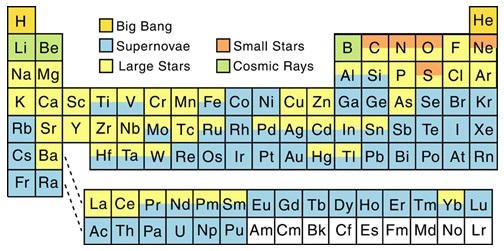Universe Today | Astronomy Without A Telescope | 14 Aug 2010
Nucleosynthesis-relevant conditions in neutrino-driven supernova outflows.The production of elements in supernova explosions is something we take for granted these days. But exactly where and when this nucleosynthesis takes place is still unclear – and attempts to computer model core collapse scenarios still pushes current computing power to its limits.
Stellar fusion in main sequence stars can build some elements up to, and including, iron. Further production of heavier elements can also take place by certain seed elements capturing neutrons to form isotopes. Those captured neutrons may then undergo beta decay leaving behind one or more protons which essentially means you have a new element with a higher atomic number (where atomic number is the number of protons in a nucleus).
This ‘slow’ process or s-process of building heavier elements from, say, iron (26 protons) takes place most commonly in red giants (making elements like copper with 29 protons and even thallium with 81 protons).
But there’s also the rapid or r-process, which takes place in a matter of seconds in core collapse supernovae (being supernova types 1b, 1c and 2). Rather than the steady, step-wise building over thousands of years seen in the s-process – seed elements in a supernova explosion have multiple neutrons jammed in to them, while at the same time being exposed to disintegrating gamma rays. This combination of forces can build a wide range of light and heavy elements, notably very heavy elements from lead (82 protons) up to plutonium (94 protons), which cannot be produced by the s-process.
Prior to a supernova explosion, the fusion reactions in a massive star progressively run through first hydrogen, then helium, carbon, neon, oxygen and finally silicon - from which point an iron core develops which can't undergo further fusion. As soon as that iron core grows to 1.4 solar masses (the Chandrasekhar limit) it collapses inwards at nearly a quarter of the speed of light as the iron nuclei themselves collapse.
The rest of the star collapses inwards to fill the space created but the inner core 'bounces' back outwards as the heat produced by the initial collapse makes it 'boil'. This creates a shockwave – a bit like a thunderclap multiplied by many orders of magnitude, which is the beginning of the supernova explosion. The shock wave blows out the surrounding layers of the star – although as soon as this material expands outwards it also begins cooling. So, it's unclear if r-process nucleosynthesis happens at this point.
But the collapsed iron core isn't finished yet. The energy generated as the core compressed inwards disintegrates many iron nuclei into helium nuclei and neutrons. Furthermore, electrons begin to combine with protons to form neutrons so that the star's core, after that initial bounce, settles into a new ground state of compressed neutrons – essentially a proto-neutron star. It is able to 'settle' due to the release of a huge burst of neutrinos which carries heat away from the core.
It's this neutrino wind burst that drives the rest of the explosion. It catches up with, and slams into, the already blown-out ejecta of the progenitor star's outer layers, reheating this material and adding momentum to it. Researchers (below) have proposed that it is this neutrino wind impact event (the 'reverse shock') that is the location of the r-process.
It's thought that the r-process is probably over within a couple of seconds, but it could still take an hour of more before the supersonic explosion front bursts through the surface of the star, delivering some fresh contributions to the periodic table.
- II. The reverse shock in two-dimensional simulations - A Arcones, H Janka
arXiv.org > astro-ph > arXiv:1008.0882 > 04 Aug 2010 (pdf)
- I. Spherically symmetric hydrodynamic simulations - A Arcones, H Janka, L Scheck
arXiv.org > astro-ph > arXiv:astro-ph/0612582 > 20 Dec 2006 (v1), 21 Mar 2007 (v2) (pdf)
- Reviews of Modern Physics 69(4) (1997) DOI: 10.1103/RevModPhys.69.995 (pdf)
- Reviews of Modern Physics 29(4) (1957) DOI: 10.1103/RevModPhys.29.547 (pdf)


